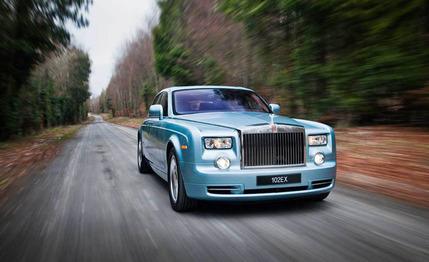
 Prototype Drive
Prototype Drive
A battery-powered Rolls-Royce is the answer to a question no one asked. When a car that Rolls code-named 102EX surfaced at last month’s Geneva auto show, skepticism reigned. Offered an opportunity to experience this radical alternative to V-12 propulsion, we took the bait, in spite of the fact that our drive was scheduled for April Fools’ Day—the ideal moment for jokes and hoaxes, even in England.
I quickly learned that the 102EX—a.k.a. the Phantom Experimental Electric—is no hoax and that the motivation for building this one-off did not bubble up from owner discontent. To the contrary, the highly opinionated captains of the universe who buy Rolls-Royces are smitten with their V-12s, and they’d prefer that the factory leave them alone. But last year a harsh reality rattled this illustrious brand’s board of directors: V-12 engines are not sustainable.
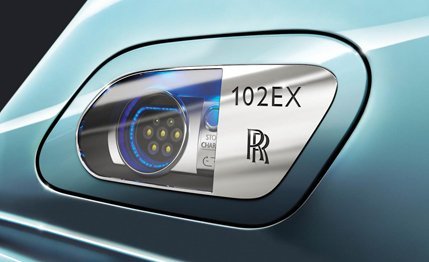

Without knowing whether the end would come from environmentalist outcry, government legislation, or mega-city mayors bent on purging internal combustion from clogged streets, Rolls-Royce’s top managers realized that the end of large-displacement, gas-guzzling, dozen-cylinder engines would eventually arrive. Instead of waiting for doom to descend, the board authorized an engineering team headed by David Monks to conjure up a sensible alternative to the V-12–powered Ghosts and Phantoms delivered last year to 2700 well-heeled customers.
Monks and Rolls-Royce chief engineer Andrew Martin acknowledge that it was not their intention to reinvent the electric car. They simply gathered proven electrical components and assembled them into a donor left-hand-drive Phantom sedan with minimal disturbance to the production blueprints. With help from Lotus Engineering (instead of parent BMW), a battery pack and electrical controllers were configured to fit where the 6.7-liter V-12 and six-speed ZF automatic normally live. In the space vacated by the fuel tank, a pair of AC motors was installed along with a single-speed transmission to energize the rear wheels. No trunk space was lost, and the increase in curb weight was reasonably modest—at least in the context of a nearly three-ton automobile—at about 400 pounds.
Global Collaboration on Genteel Electrification
Delving deeper into the bill of materials, I learned that Dow Kokam manufactured the 96 prismatic lithium-ion battery cells in Korea and the Scottish firm Axeon assembled them into a 1411-pound, 338-volt pack that provides a 71-kWh energy capacity and a claimed 124 miles of range. (For reference, a Nissan Leaf’s pack holds 24 kWh.) Colorado-based UQM supplied the synchronous permanent-magnet motors, delivering a combined 389 hp and 590 lb-ft of torque to the XTrac transaxle. Another American firm—Seton—provided the experimental vegetable-tanned leather trim for the 102EX’s seats, instrument panel, doors, and floor surfaces.
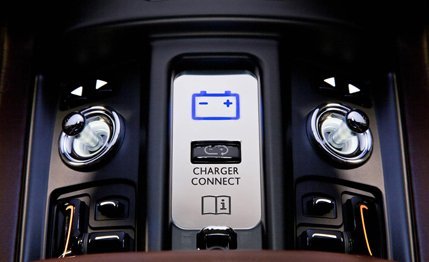

During my 30-minute taste test on rural roads near the factory in Goodwood, West Sussex, England, the electric propulsion system performed every task asked of it with immaculate composure. Like the standard V-12 edition, the Phantom EE accelerated from rest with the fluid grace of a summer breeze. Under sustained thrust, there was an occasional hint of dynamo hum, but for the most part, the drivetrain dialogue was overwhelmed by the hiss of tires on pavement and the whoosh of air flowing past the side windows. According to Rolls-Royce measurements, acceleration is somewhat less forceful than with pistons—“under eight seconds” to 60 mph versus their 5.7-second claim for the conventional car. According to the company, this is roughly equivalent to ferrying an extra passenger or two in the V-12 model.
One instance where the electric challenger clearly beats the incumbent is in a passing maneuver. With a dozen cylinders to rouse and six gears to shuffle, there’s a moment’s hesitation and a slight hitch when the standard Phantom changes down to gather speed in response to a prod of the gas pedal. It’s smooth, but it doesn’t have the seamless surge forward that occurs when the electric’s accelerator is floored.
Two levels of regeneration are offered. In the normal setting, it’s barely noticeable. In the setting labeled “low,” lifting off the accelerator provides deceleration roughly equivalent to engine braking. Asked for feedback related to this feature, my suggestion was to offer much more regen—to facilitate true one-pedal driving during most conditions—controlled in a continuously variable manner by a rotary knob instead of a two-position switch.
The electric motors respond with impressive enthusiasm from a stoplight because of their ability to deliver maximum torque at minimal rpm. Considering the smoothness, operational silence, and overall poise engineered into this experimental model, any existing Rolls-Royce owner would have to be extremely cranky to find something not to like. From a purely functional standpoint, this electric Roller is ready for prime time.
Experimental Inside, Too
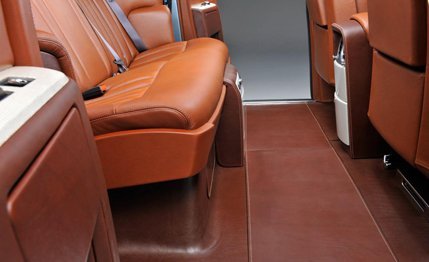

While they were at it, Rolls-Royce engineers took this opportunity to try out a few deviations from their normal luxurious interior trim. The experimental Corinova leather is more natural—both the processes used in its manufacture and in its appearance. This trim looks and feels like traditional hide, still exhibiting actual animal creases, a nice grain, and an endearing touch. It’s also tough enough to serve as floor covering, although not without sustaining scuff marks in areas not fitted with lamb’s-wool throw rugs.
In lieu of classic wood paneling, the Phantom EE is fitted with casings made of aluminized woven glass strands. They look like bleached-white carbon fiber. To provide an appropriate contrast, flat areas are trimmed in a machined-texture aluminum-foil material. The net result is probably too cold and technical-looking for this clientele, but give Rolls credit for venturing down alternative avenues.
Exterior deviations are quite minimal. Naturally, there are no exhaust pipes. To highlight the lack of a gas cap, the filler flap is transparent, showcasing the charging connection socket and the LEDs that glow blue during charging, green when the battery is replenished, and red if some electrical issue arises. In the event a noncontact inductive charging method is used, a successful connection is indicated with a violet LED. A second set of indicators is located on the center console. The recharge ritual takes up to eight hours on 220 volts or up to 20 hours on 110 volts.
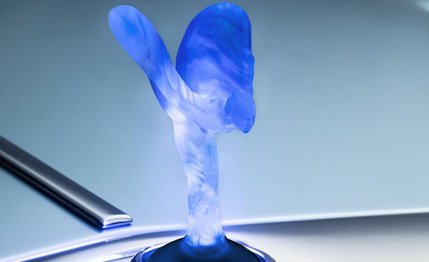

Two other custom touches are Atlantic Chrome paint accented with ceramic nano particles—claimed to be 1000 times smaller than normal metallic additives—that give the pale blue-green finish a deeper luster. A composite-plastic (Makrolon) Spirit of Ecstasy has an LED lamp in its base to impart a soft blue glow throughout the figurine. Unfortunately, in daylight, illumination is only visible to about thigh-high on the flying lady; it’s not until nightfall that the blue hue fills her wingtips. This alternative to a pewter-look Spirit of Ecstasy (actually a stainless-steel investment casting) has been available as a Phantom option with few takers so far.
Although I give Rolls engineers top marks for the refinement they tuned into the Phantom EE, constructing a single experimental electric is the easy part. The hard work lies ahead. Step one is sharing this car with the brand’s owner family on a global exposure tour that will run from May through November. Step two is engineering some sort of V-12 alternative for the future, and step three is providing a traditionally high level of customer support if and when that car hits the market.
With any pure electric, there are daunting what-ifs to contemplate, such as the scope of roadside assistance needed to rescue owners stranded by a flat battery or what to do when the electrical grid takes an unscheduled day off. Factoring in an ill-mannered combustion engine for range extension is not an option here. Instead, the Rolls-grade alternative would have to be a truly elegant solution, such as a miniature fuel cell with an emergency canister of pressurized nitrogen.
Nobody said the trip to the future would be as easy as a blissful jaunt in a current Rolls-Royce costing a king’s ransom.